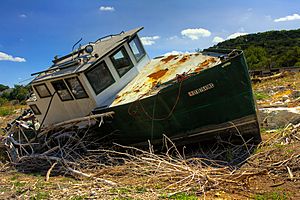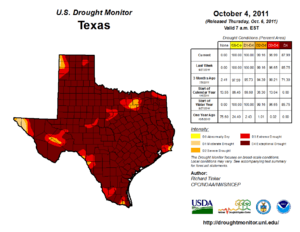2010–2013 Southern United States and Mexico drought facts for kids
The 2010–2013 Southern United States and Mexico drought was a very serious dry period. It affected the Southern United States, including states like Texas, Louisiana, Arkansas, Mississippi, Alabama, Georgia, South Carolina, North Carolina, Florida, and Oklahoma. It also hit the Southwestern States such as Kansas, Colorado, New Mexico, and Arizona, along with large parts of Mexico. This drought lasted for three years, from 2010 to 2013.
Texas was hit the hardest by this drought. It had its driest 12-month period ever recorded from August 2010 to July 2011. May 2011 was also the worst dry spell in Texas since 1895. Places like Lubbock, Texas, McAllen, Harlingen, Brownsville, and Corpus Christi were among the most affected cities. The drought caused about $7.62 billion in losses for crops and farm animals in Texas. This was a new record, much higher than the $4.1 billion lost in 2006.
Contents
How the Drought Started and Spread
The drought began because of a strong weather pattern called La Niña in the summer of 2010. La Niña usually brings less rain to the southern United States. People noticed its effects right away. Many southern areas, like Texas and Georgia, usually get a lot of rain in the summer. But this was their driest summer in the 21st century, with record low rainfall.
In 2011, the drought mostly stayed in the Deep South. Other areas, like the Mid-South, even had floods from severe storms. But the drought got worse in the Deep South. Texas had its second-driest year ever in 2011, Oklahoma had its fourth-driest, and Georgia had its seventh-driest. The winter of 2011–12 was one of the driest winters for the eastern and central United States.
In the spring of 2012, the drought grew a lot. It spread from the Deep South to the Midwest, Mid-South, Great Plains, and Ohio Valley. At its worst in August 2012, the drought covered about 81% of the entire United States.
During the winter of 2012–13, heavy rain and snow finally brought relief to the southern and eastern United States. Some areas even had severe flooding. By March 2013, the eastern United States was free from drought, which meant the 2010–13 southern U.S. drought had ended. However, the Great Plains stayed dry until 2014. A new drought also started in the western United States in 2013, and it still affects some areas today.
What Were the Effects of the Drought?
The drought caused a serious lack of water in the southern plains and Rocky Mountains. It also led to many wildfires. Some of the big fires included the 2011 Texas wildfires, the Wallow Fire and Horseshoe 2 Fire in Arizona, the Whitewater-Baldy Complex Fire and Little Bear Fire in New Mexico, and the 2012 Colorado wildfires in Colorado.
Mexico was also badly affected. The drought ruined crops, killed over a million cattle, and made it hard for people to find enough water and food. This drought was described as the worst Mexico had seen in 70 years.
By the end of August 2011, 251 out of 254 counties in Texas had a ban on outdoor burning. This meant people couldn't light fires outside. Lake levels in Texas dropped a lot, some by as much as 50 feet! For example, E.V. Spence Reservoir had less than 1% of its water capacity in July 2011. When the water went down, it revealed things that were once underwater, like an old Native American skull and a piece of a Space Shuttle Columbia tank. On August 30, several homes in Oklahoma City were destroyed, and 1,500 acres of forest burned. Hundreds of homes had to be evacuated.
The drought was very bad for cattle ranches in Texas and Oklahoma. Ranchers had to sell or kill many of their animals. This caused the number of cattle in the country to drop to its lowest level in decades.
In spring 2012, rainfall improved conditions in many parts of Texas. By April 12, 2012, only 14% of the state was in "exceptional" drought, which is the worst level. This was much better than the 88% at the drought's peak.
In spring and summer 2012, the drought grew even more. It became the 2012 North American drought, affecting more than 80% of the contiguous United States (the main part of the U.S. without Alaska and Hawaii).
The Drought's Impact on Texas
According to the U.S. Drought Monitor, which is a project by several government groups, about 4 percent of Texas was still in "extreme" or "exceptional" drought by late November 2012. These are the two most severe drought categories.
The drought caused billions of dollars in losses across Texas. Farmers and ranchers were among those most affected. The Texas A&M AgriLife Extension Service estimated that Texas farmers and ranchers lost almost $7.6 billion because of the drought.
The drought and very hot weather made 2011 the worst year for wildfires in Texas history. From November 15, 2010, to September 29, 2011, Texas had 23,835 fires. These fires burned over 3.8 million acres and destroyed 2,763 homes in Texas. The timber (trees) lost to drought and wildfires could have made $1.6 billion worth of products. This had a total economic impact of $3.4 billion in East Texas.
See also
- 2012–13 North American drought
- 2010 Northern Hemisphere summer
- Days of Prayer for Rain in the State of Texas
- 2011 North American heat wave
- Summer 2012 North American heat wave
- 2012 Colorado wildfires
- 2012 Oklahoma wildfires
- Global warming
- Desertification
- La Niña






